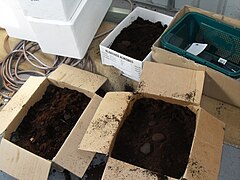Used coffee grounds
 Used coffee grounds in boxes. | |
| Usage |
|
|---|---|
Used coffee grounds is the result of brewing coffee, and are the final product after preparation of coffee. Used coffee grounds are generally regarded as waste, and is usually thrown away or composted. In the late 19th century, used coffee grounds were used to adulterate pure coffee.[1]
Usage[]
In gardens[]

In gardens, coffee grounds may be used for composting or as a mulch[2] as they are known to slowly release nitrogen into the soil. The dry coffee grounds contain significant amounts of potassium (11.7 g/kg), magnesium (1.9 g/kg), and phosphorus (1.8 g/kg).[3] They are especially appreciated by worms and acid-loving plants such as blueberries,[4] although due to acids being leached from the grounds while in use, they typically have a neutral pH. Used coffee grounds are particularly noted as a soil amendment.[5] Gardeners have reported the use of used coffee grounds as a slug and snail repellent,[2][6] but this has not yet been scientifically tested.[7] Some commercial coffee shops run initiatives to prevent the grounds from going to waste, including Starbucks' "Grounds for your Garden" project,[8] and community sponsored initiatives exist, such as "Ground to Ground" [9] or the 'Green Coffee Shop Scheme' in Cambridgeshire, UK.[10]

Use in fortune telling[]
In divination and fortune-telling the patterns of coffee grounds are used for predictions.
Other uses[]
Initiatives have succeeded using coffee grounds as a substrate for the cultivation of mushrooms (including oyster mushrooms).[11][12] Used coffee grounds have other homemade uses in wood staining, air fresheners, and body soap scrubs.[2] They may also be used industrially in biogas production or to treat wastewater.[7] In 2021, Glouchestershire-based football club Forest Green Rovers trialled a kit made from 35% used coffee grounds combined with recycled plastic.
See also[]
- Ecological effects of coffee
References[]
- ^ Pendergrast, Mark "Uncommon grounds : the history of coffee and how it transformed our world" 2010 Basic Books. ISBN 978-0-465-02404-9
- ^ Jump up to: a b c "Don't Throw Out Your Leftover Coffee Grounds!". Huffington Post. 4 August 2014. Retrieved 25 December 2014.
- ^ Ballesteros, Lina F.; Teixeira, José A.; Mussatto, Solange I. (December 2014). "Chemical, Functional, and Structural Properties of Spent Coffee Grounds and Coffee Silverskin". Food and Bioprocess Technology. 7 (12): 3493–3503. doi:10.1007/s11947-014-1349-z. hdl:1822/31900. S2CID 38776511.
- ^ Martin, Deborah L; Gershuny, Grace, eds. (1992). "Coffee wastes". The Rodale book of composting. Emmaus, PA: Rodale Press. p. 86. ISBN 978-0-87857-991-4. Retrieved 5 January 2010.
- ^ "Coffee Grounds Perk up Compost Pile With Nitrogen". Life at OSU. 10 June 2009. Retrieved 1 April 2018.
- ^ "NORTH COAST GARDENING: Winter vegetable growing". Eureka Times-Standard. 24 December 2014. Retrieved 25 December 2014.
- ^ Jump up to: a b Chalker-Scott, Ph.D, Linda (2009). "Coffee grounds— will they perk up plants?" (PDF). Master Gardener. Puyallup Research and Extension Center, Washington State University. Retrieved 25 December 2014.CS1 maint: multiple names: authors list (link)
- ^ "Coffee for Your Plants? Starbucks Offers Free Coffee Grounds for Gardeners". Starbucks.com. Retrieved 13 December 2015.
- ^ "About Us | Coffee Grounds to Ground". Groundtoground.org. Retrieved 26 October 2011.
- ^ "Green Coffee Shop Scheme". Cambridge Food Hub. 8 May 2019. Retrieved 25 October 2019.
- ^ (in Dutch) Zelf oesterzwammen kweken op basis van ... koffiegruis?
- ^ (in Dutch) Oesterzwammen en koffiedik?
- Coffee derivatives
- Horticulture and gardening
- Composting
- Food waste
